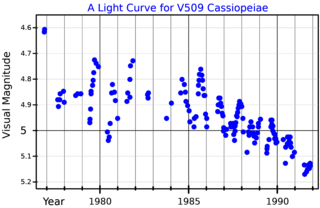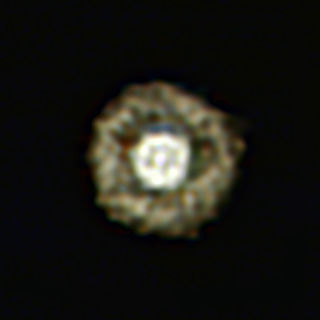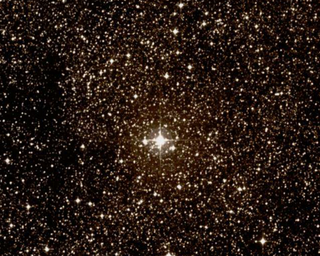HD 179821 or V1427 Aquilae is either a post-red supergiant yellow hypergiant or a post-AGB yellow supergiant star in the constellation of Aquila, surrounded by a detached dust shell. It is a semi-regular variable nearing the end of its life.
HD 179821 or V1427 Aquilae is either a post-red supergiant yellow hypergiant or a post-AGB yellow supergiant star in the constellation of Aquila, surrounded by a detached dust shell. It is a semi-regular variable nearing the end of its life.
HD 179821 was first catalogued as an unremarkable 8th magnitude star at the start of the 20th century. [12] It was later listed as a spectral standard G4 0-Ia, indicating a highly luminous star type now known as a hypergiant. [13]
It was first considered notable for its infrared excess and double-peaked spectral energy distribution in the infrared. [14] These were considered to be indicators of surrounding dust and HD 179821 was identified as a possible proto-planetary nebula. [15] Variability was also detected. [16]
High resolution spectroscopic studies and modern space-based observations have revealed an unusual chemical makeup and a hollow spherical dust shell, but haven't fully resolved whether HD 179821 is a highly luminous yellow hypergiant or a dimmer, lower-mass post-AGB star. [10]
HD 179821 has a cold detached dust shell that has been studied with the help of the Hubble Space Telescope. The shell is approximately circular in shape, has an inner diameter of ~3".3 corresponding to 20,000 AU at 6,000 pc, and an outer diameter of 5".7 or more, with the star 0".35 from the centre of the shell. The current mass loss is low, but during the formation of the shell it is estimated to have been 4×10−4 M☉/yr, an exceptionally high rate being comparable to that of the archetypical OH/IR red supergiant, VY Canis Majoris. [17] Like its constellation neighbor and also hypergiant star IRC +10420, it is surrounded by an extended reflection nebula. Discovered at near-IR wavelength, this indicates a massive star [18] and, as with the reflection nebula around IRC +10420, it may be masking a star hotter than the given G5 spectral type. [19]
It is that which contributes to a double-peaked spectral energy distribution. [20] It is estimated the star has lost about 10% of its initial mass after being a red supergiant star just 1,600 years ago, [17] and is a likely supernova candidate. [21]
The distance was once estimated to be around 6,000 parsecs. It has a high luminosity of between 1.26×105 and 2.95×105 L⊙ and a radius of between 400 and 450 R☉. [11] [9] It has a high radial velocity of +100 km/s. [22] According to the studies of Jura et al (2001), the star may explode as a supernova in the next 100,000 years.

HD 179821 is a semiregular variable star with the variable star designation V1427 Aquilae. Between 1899 and 1989, its photographic apparent magnitude varied erratically between about magnitudes 9 and 10, although coverage is not complete and some larger variations may have been missed. It then varied by no more than 0.1 magnitudes until 2009, at a visual magnitude around 8.1. [11]
The colour of the star changed noticeably so that the variability at different wavelengths is not consistent. In general, the star became bluer from 1899 until 1990, and then redder again. The colour changes most likely reflect changes in the effective temperature, and probably underlying evolutionary trends with the star performing a blue loop between temperatures of 4,000 K and 8,000 K. [11] Pulsations for much of this time occurred with an approximate period of 100 to 150 days, although this increased to 250 days between 2010 and 2017, which is expected for stars which are decreasing in temperature. [11] At its coolest, the spectral type has been recorded as K4, [3] while near its hottest in 2007 it was classified as F7. [24]
The chemical composition of this star differs from that of other yellow supergiant stars. The star is moderately metal-deficient [18] and the main elements present in the star (apart from hydrogen and helium) are oxygen, carbon and nitrogen. Molecules such as hydrogen isocyanide, sulfur monoxide and HCO+ have been detected in the circumstellar envelope of the star. These molecules may result from an active photochemistry, generated by UV photons emitted by the central star as it warms up, or can be produced in shocks. [20]
While most authors consider HD 179821 to be a warm hypergiant star, [25] others think it is actually a protoplanetary nebula or a smaller post-AGB star at a distance of 1 kiloparsec (3,200 light years). [26] In that case the star's luminosity and radius would be much lower, around 16,000 times that of the Sun and 60 to 80 R☉, and its initial mass would be equal to the current mass of the Sun. [11] [10]
This discrepancy arises because its distance was too great to be measured by parallax before the Gaia mission and it has some properties of both a yellow hypergiant and a protoplanetary nebula/Post-AGB star. [8] [10] Gaia Data Release 2 gives a parallax of 0.19 mas implying a distance around 5,300 pc . [1]

Sagitta is a dim but distinctive constellation in the northern sky. Its name is Latin for 'arrow', not to be confused with the significantly larger constellation Sagittarius 'the archer'. It was included among the 48 constellations listed by the 2nd-century astronomer Ptolemy, and it remains one of the 88 modern constellations defined by the International Astronomical Union. Although it dates to antiquity, Sagitta has no star brighter than 3rd magnitude and has the third-smallest area of any constellation.

Supergiants are among the most massive and most luminous stars. Supergiant stars occupy the top region of the Hertzsprung–Russell diagram with absolute visual magnitudes between about −3 and −8. The temperature range of supergiant stars spans from about 3,400 K to over 20,000 K.

Red supergiants (RSGs) are stars with a supergiant luminosity class of spectral type K or M. They are the largest stars in the universe in terms of volume, although they are not the most massive or luminous. Betelgeuse and Antares A are the brightest and best known red supergiants (RSGs), indeed the only first magnitude red supergiant stars.

V509 Cassiopeiae is one of two yellow hypergiant stars found in the constellation Cassiopeia, which also contains Rho Cassiopeiae.

A yellow hypergiant (YHG) is a massive star with an extended atmosphere, a spectral class from A to K, and, starting with an initial mass of about 20–60 solar masses, has lost as much as half that mass. They are amongst the most visually luminous stars, with absolute magnitude (MV) around −9, but also one of the rarest, with just 20 known in the Milky Way and six of those in just a single cluster. They are sometimes referred to as cool hypergiants in comparison with O- and B-type stars, and sometimes as warm hypergiants in comparison with red supergiants.

A yellow supergiant (YSG) is a star, generally of spectral type F or G, having a supergiant luminosity class. They are stars that have evolved away from the main sequence, expanding and becoming more luminous.

HR 4049, also known as HD 89353 and AG Antliae, is a binary post-asymptotic-giant-branch (post-AGB) star in the constellation Antlia. A very metal-poor star, it is surrounded by a thick unique circumbinary disk enriched in several molecules. With an apparent magnitude of about 5.5, the star can readily be seen under ideal conditions. It is located approximately 1,700 parsecs (5,500 ly) distant.

V1401 Aquilae is a single, semi-regular pulsating star in the equatorial constellation of Aquila. It has the designation HD 190390 from the Henry Draper Catalogue, and was formerly designated 64 Sagittarii. The evolutionary status of the star is unclear, and it has been classified as a post-AGB object, a UU Herculis variable, or belonging to the W Virginis variable subclass of the type II Cepheids. It is dimly visible to the naked eye with an apparent visual magnitude that fluctuates around 6.38. Based on parallax measurements, it is located at a distance of approximately 2,380 light years. It lies 21.5° from the galactic plane.

S Persei is a red supergiant or hypergiant located near the Double Cluster in Perseus, north of the cluster NGC 869. It is a member of the Perseus OB1 association and one of the largest known stars. If placed in the Solar System, its photosphere would engulf the orbit of Jupiter. It is also a semiregular variable, a star whose variations are less regular than those of Mira variables.

6 Cassiopeiae is a white hypergiant in the constellation Cassiopeia, and a small-amplitude variable star.

A hypergiant (luminosity class 0 or Ia+) is a very rare type of star that has an extremely high luminosity, mass, size and mass loss because of its extreme stellar winds. The term hypergiant is defined as luminosity class 0 (zero) in the MKK system. However, this is rarely seen in literature or in published spectral classifications, except for specific well-defined groups such as the yellow hypergiants, RSG (red supergiants), or blue B(e) supergiants with emission spectra. More commonly, hypergiants are classed as Ia-0 or Ia+, but red supergiants are rarely assigned these spectral classifications. Astronomers are interested in these stars because they relate to understanding stellar evolution, especially star formation, stability, and their expected demise as supernovae.

V4381 Sagittarii is a variable star in the constellation Sagittarius. A white supergiant of spectral type A2/A3Iab, it is an Alpha Cygni variable that varies between apparent photographic magnitudes 6.57 and 6.62. Its visual apparent magnitude is about 6.54.

IRAS 17163−3907, also known as Hen 3-1379, is a yellow hypergiant star located 13,000 light years from Earth in the constellation of Scorpius. The star is embedded in thick shells of expelled gases and dust, and owing to its appearance has been nicknamed by astronomers the "Fried Egg Nebula". Yellow hypergiants are in an extremely active phase of their evolution.

HD 33579 is a white/yellow hypergiant and one of the brightest stars in the Large Magellanic Cloud (LMC). It is a suspected variable star.

IRC+10420, also known as V1302 Aql, is a yellow hypergiant star located in the constellation of Aquila at a distance of 4-6 kiloparsecs of the Sun.

Westerlund 1 W26 or Westerlund 1 BKS AS is a red supergiant located at the outskirts of the Westerlund 1 super star cluster. It is one of the largest known stars and the most luminous supergiant stars discovered so far with radius calculated to be in excess of a thousand times the solar radius, and a luminosity of over 200,000 times the solar luminosity. If placed at the center of the Solar System, its photosphere would engulf the orbit of Jupiter.

V915 Scorpii is an orange hypergiant variable star in the constellation Scorpius.

HD 143183 is a red supergiant variable star of spectral type M3Ia in constellation Norma. It is a member of the Norma OB1 association, at a distance of about 2 kiloparsecs. It is one of the most luminous red supergiants with a luminosity over 100,000 times greater than the Sun (L☉), and is as well one of the largest stars with a radius more than a thousand times that of the Sun (R☉). Older studies frequently calculated higher luminosities and radii. It has an estimated mass loss rate of 5×10−5 M☉ per year and has been once described as a cool hypergiant. It is surrounded by a dozen early-type stars and a circumstellar nebula which extends 0.12 parsecs (0.39 ly).

V1027 Cygni is a luminous yellow supergiant star located in the constellation of Cygnus, about 14,000 light years away. For a time, it was thought that it could be a low-mass post-AGB star, however recent parallax measurements published in Gaia DR3 have shown this to likely not be the case, and instead it is likely a massive yellow supergiant star.